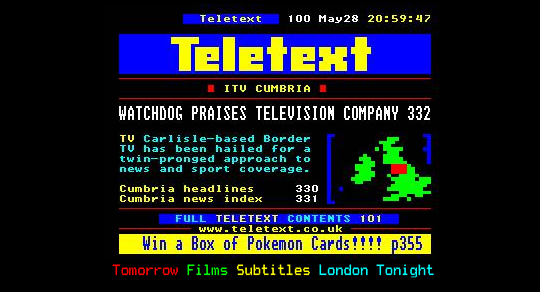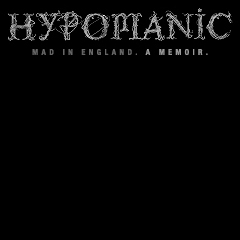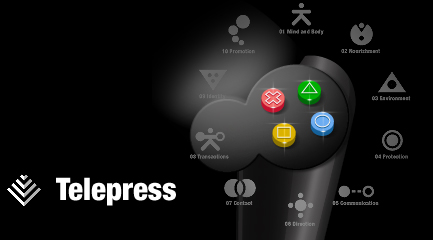| |
|
|
 |
|
| The
Life of Teletext |
|
In
about 1970 the BBC had a brainstorming session in which it was decided
to start researching ways to send closed captioning information to
audience. As the Teledata research continued they became increasingly
interested in using the same system for delivering any sort of information,
not just closed captioning. Displaying subtitles requires limited
bandwidth, at a rate of perhaps a few words per second. However, by
combining even a slow data rate with a suitable memory, pages of information
could be sent and stored in the TV for later recall. In 1972 the BBC
demonstrated their system, now known as Ceefax ("see facts"),
on various news shows. In 1974 all the services agreed a standard
for displaying the information. The display would be a simple 40x24
grid of text, with some graphics characters for constructing simple
graphics. This standard was called CEPT1. The standard did not define
the delivery system, so both Viewdata-like and Teledata-like services
could at least share the TV-side hardware (which at that point in
time was quite expensive). The standard also introduced a new term
that covered all such services, teletext. The "Broadcast Teletext
Specification" was published in September 1976 jointly by the
IBA, the BBC and the British Radio Equipment Manufacturers's Association.
Introduction of Teletext
Following test transmissions in 1973–74, towards the end of
1974 the BBC news department put together an editorial team of nine,
including and led by Editor Colin McIntyre, to develop a news and
information service. Initially limited to 30 pages, the Ceefax service
was later expanded to 100 pages and was launched formally in 1976.
It was followed quickly by ORACLE and Prestel. Development was limited
until the first TV sets with built-in decoders started appearing in
1977, but by 1982 there were two million such sets, and by the mid-80s
they were available as an option for almost every European TV set.
It took another decade before the decoders became a standard feature
on almost all sets over 15" (Teletext is still usually only an
option for smaller "portable" sets). From the mid-80s both
Ceefax and ORACLE were broadcasting several hundred pages on every
channel, slowly changing them throughout the day.
In 1993 ORACLE in the United Kingdom was replaced as content provider
by Teletext Ltd, now owned by Daily Mail and General Trust and Media
Ventures International. Branding themselves simply as "Teletext",
they operate on ITV, Channel 4 and, more recently, Five.
Increasingly, the Internet is replacing teletext as a source of information
on TV programmes, weather, news and travel. However, many broadcasters
are now supplying their teletext feeds with content created for their
websites, and put their complete set of teletext pages on the web.
Digital Teletext
Digital television introduced "digital teletext" which,
despite the previous teletext standard's digital nature, has entirely
different standards. Despite the age of the technology, VBI teletext
(with its now quaint looking 1970s-style computer graphics) remains
very popular; although the service may stop upon the cessation of
European analogue TV broadcasting, sometime before 2012. Some digital
television platforms such as Sky Digital incorporate separate teletext
streams (used by the BBC from 1998 to 2004, and still used by Irish
broadcaster RTÉ), which are provided to the television set
in the normal analogue TV manner. Such emulation of analogue teletext
on digital TV platforms may ensure its continued use for some time
(particularly as there are no plans for an immediate transition to
digital terrestrial transmission in some countries, such as the Republic
of Ireland). Unless people find another way to use their television
sets and remote controls. |
|


